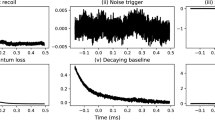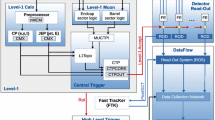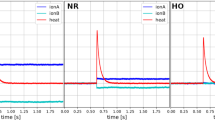Abstract
Many scientific applications from rare-event searches to condensed matter system characterization to high-rate nuclear experiments require time-domain triggering on a raw stream of data, where the triggering is generally threshold-based or randomly acquired. When carrying out detector R &D, there is a need for a general data acquisition (DAQ) system to quickly and efficiently process such data. In the SPLENDOR collaboration, we are developing the Python-based SPLENDAQ package for this exact purpose—it offers two main features for offline analysis of continuous data: a threshold triggering algorithm based on the time-domain optimal filter formalism and an algorithm for randomly choosing nonoverlapping segments for noise measurements. Combined with the commercially available Moku platform, developed by Liquid Instruments, we have a full pipeline of event building off raw data with minimal setup. Here, we review the underlying principles of this detector-agnostic DAQ package and give concrete examples of its utility in various applications.




Similar content being viewed by others
References
M.A. Howe, G.A. Cox, P.J. Harvey, F. McGirt, K. Rielage, J.F. Wilkerson, J.M. Wouters, Sudbury neutrino observatory neutral current detector acquisition software overview. IEEE Trans. Nucl. Sci. 51, 878 (2004). https://doi.org/10.1109/TNS.2004.829527
V. Khachatryan et al. (collaboration CMS Collaboration), The CMS trigger system. J. Instrum. 12(01), P01020. https://doi.org/10.1088/1748-0221/12/01/P01020, arXiv:1609.02366 [physics.ins-det]
S. Di Domizio, A. Branca, A. Caminata, L. Canonica, S. Copello, A. Giachero, E. Guardincerri, L. Marini, M. Pallavicini, Vignati, A data acquisition and control system for large mass bolometer arrays. J. Instrum. 13(12), P12003. https://doi.org/10.1088/1748-0221/13/12/P12003, arXiv:1807.11446 [physics.ins-det]
J.S. Wilson et al., The level-1 trigger for the SuperCDMS experiment at SNOLAB. J. Instrum. 17(07), P07010. https://doi.org/10.1088/1748-0221/17/07/P07010, arXiv:2204.13002 [physics.ins-det]
S.L. Watkins ( collaboration SPLENDOR Collaboration), SPLENDAQ (2023). https://www.github.com/splendor-collab/splendaq
V.T. Jordanov, G.F. Knoll, A.C. Huber, J.A. Pantazis, Digital techniques for real-time pulse shaping in radiation measurements. Nucl. Instrum. Meth. Phys. Res. A 353, 261 (1994). https://doi.org/10.1016/0168-9002(94)91652-7
V. Radeka, N. Karlovac, Least-square-error amplitude measurement of pulse signals in presence of noise. Nucl. Instrum. Methods 52, 86 (1967). https://doi.org/10.1016/0029-554X(67)90561-7
E. Gatti, P.F. Manfredi, Processing the signals from solid state detectors in elementary particle physics. Riv. Nuovo Cim. 9N1, 1 (1986). https://doi.org/10.1007/BF02822156
S.R. Golwala, Exclusion limits on the WIMP nucleon elastic scattering cross-section from the Cryogenic Dark Matter Search. Ph.d. thesis, school University of California, Berkeley (2000). https://doi.org/10.2172/1421437
S.L. Watkins, Athermal Phonon Sensors in Searches for Light Dark Matter. Ph.d. thesis, school University of California, Berkeley (2022). arXiv:2301.08699 [hep-ex]
C.R. Harris et al., Array programming with NumPy. Nature 585, 357 (2020). https://doi.org/10.1038/s41586-020-2649-2. arXiv:2006.10256 [cs.MS]
P. Virtanen et al., SciPy 1.0: fundamental algorithms for scientific computing in python. Nat. Methods 17, 261 (2020). https://doi.org/10.1038/s41592-019-0686-2. arXiv:1907.10121 [cs.MS]
The HDF Group, Hierarchical Data Format, version 5 (1997–2023). https://www.hdfgroup.org/HDF5/
Liquid Instruments, Moku Hardware Platforms (2023). https://www.liquidinstruments.com/
Acknowledgements
This work was supported by the U.S. Department of Energy through the Los Alamos National Laboratory. Los Alamos National Laboratory is operated by Triad National Security, LLC, for the National Nuclear Security Administration of U.S. Department of Energy (Contract No. 89233218CNA000001). Research presented in this article was supported by the Laboratory Directed Research and Development program of Los Alamos National Laboratory under project numbers 20220135DR and 20230782PRD1.
Author information
Authors and Affiliations
Contributions
SLW wrote the main manuscript text and prepared all figures.
Corresponding author
Ethics declarations
Conflict of interest
The authors declare no competing interests.
Additional information
Publisher's Note
Springer Nature remains neutral with regard to jurisdictional claims in published maps and institutional affiliations.
Rights and permissions
Springer Nature or its licensor (e.g. a society or other partner) holds exclusive rights to this article under a publishing agreement with the author(s) or other rightsholder(s); author self-archiving of the accepted manuscript version of this article is solely governed by the terms of such publishing agreement and applicable law.
About this article
Cite this article
Watkins, S.L. SPLENDAQ: A Detector-Agnostic Data Acquisition System for Small-Scale Physics Experiments. J Low Temp Phys 214, 133–142 (2024). https://doi.org/10.1007/s10909-023-03021-w
Received:
Accepted:
Published:
Issue Date:
DOI: https://doi.org/10.1007/s10909-023-03021-w




